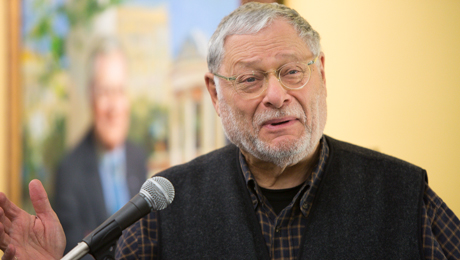By Brittney Dunkins
What circumstances lead to a newly minted university president’s untimely dismissal?
What factors turn a higher education administration south?
A new book from George Washington University President Emeritus Stephen Joel Trachtenberg, Professor Gerald B. Kauvar and the late E. Grady Bogue uncovers the answers to these questions, offering in-depth analysis of numerous failed university presidencies and recommendations for future leaders.
The university community gathered to celebrate the release of “Presidencies Derailed: Why University Leaders Fail and How to Prevent It” by Mr. Trachtenberg and Dr. Kauvar Monday. The reception and book-signing event was hosted by the Trachtenberg School of Public Policy and Public Administration.
“Gerry and I had just finished our last book, and we were sitting in the office upstairs when I asked him, ‘Have you noticed how many people are getting fired these days in the university president business?’” Mr. Trachtenberg said. “We started tracking news stories for a few weeks, and we found an extraordinarily high number of cases.”
Research and collaboration with Dr. Bogue, the former chancellor of Louisiana State University and Tennessee State University, were integral to the completion of the peer-reviewed book that was published by the Johns Hopkins University Press this year.
Mr. Trachtenberg said Dr. Bogue, who died in October, became a great friend during the process.
“We did not do this alone,” Dr. Kauvar said, noting that contributions from doctoral students, editors and colleagues were essential to the process, especially Dr. Bogue.
“Presidencies Derailed” focuses on university presidents who were fired during the first and second year of their administration— a surprising trend given that on average leaders in higher education tend to stay in their role for six to seven years.
“There are 4,000 university presidents, including heads of community colleges, in the United States,” Mr. Trachtenberg said. “In a pool that big you are going to see many who succeed, and it’s safe to say not everyone is getting fired, but these stories are interesting to track.”
Dr. Kauvar agreed, noting that there have been 100 failed university presidencies since 2012.
According to Mr. Trachtenberg, there are many reasons university leaders can fail beyond their own shortcomings, from relationships with board members to alumni influence.
The Johns Hopkins University Press has requested a new book from the duo, and this time the project will focus on the success of university presidents, Mr. Trachtenberg said.
“Interestingly enough, it is a harder book to write because you can make a test for failure,” he said. “Success, of course, is always harder to quantify.”
The new book will be dedicated to Dr. Bogue.


